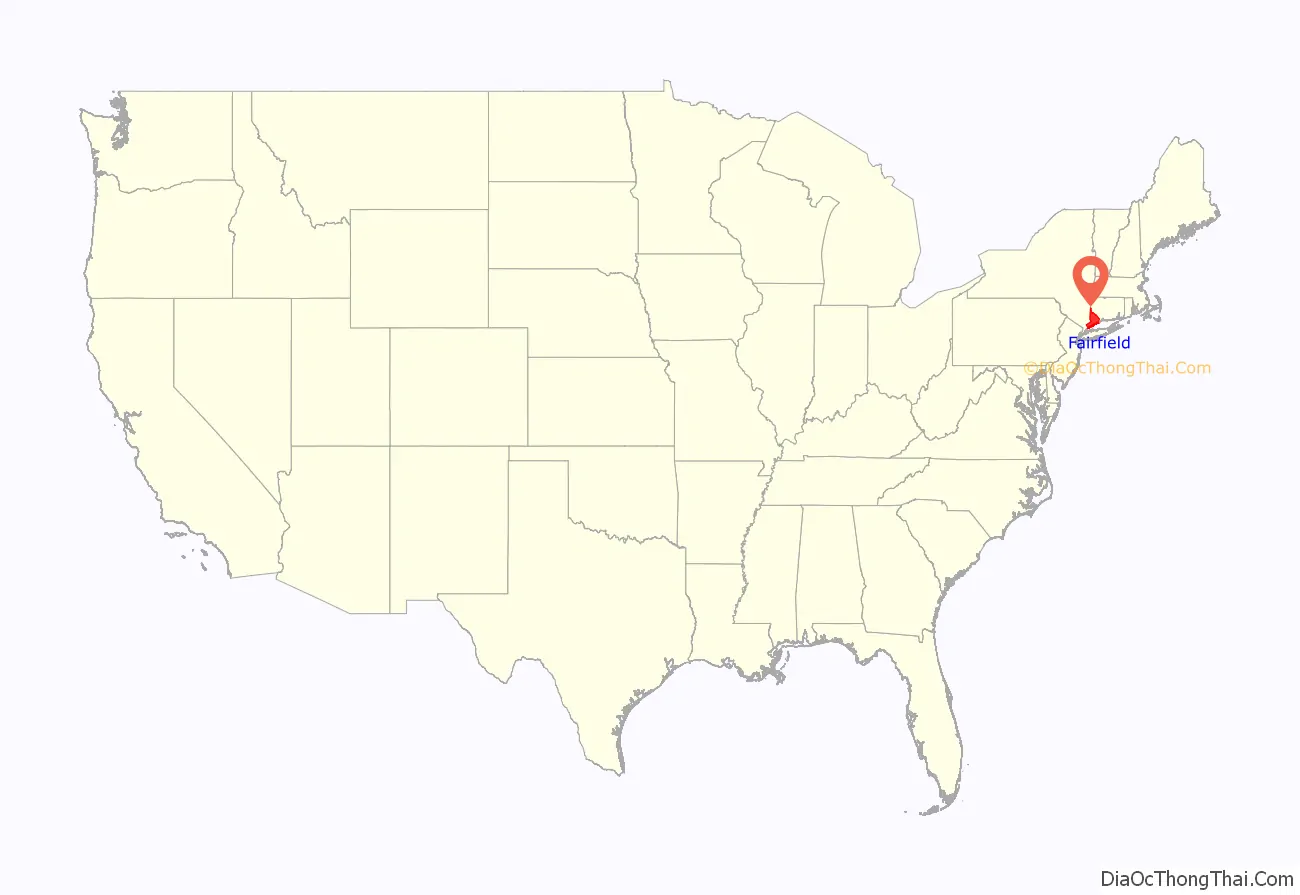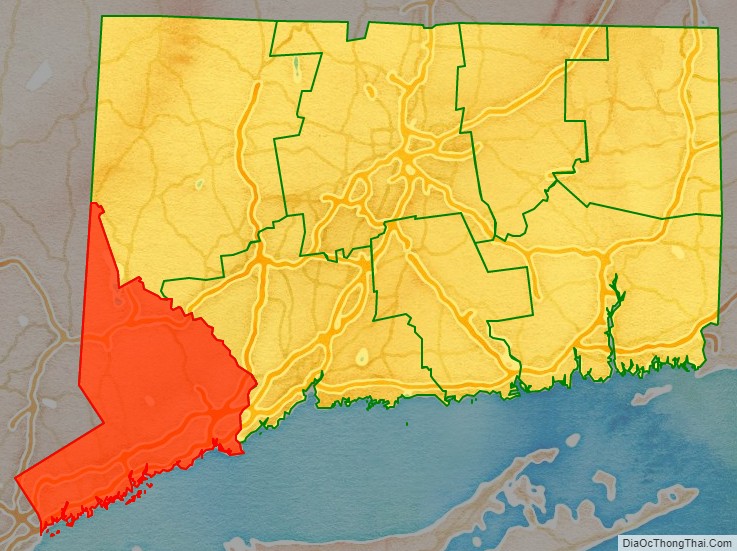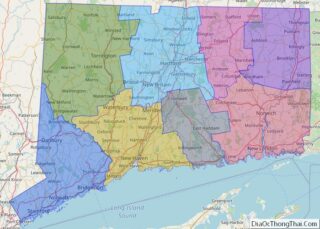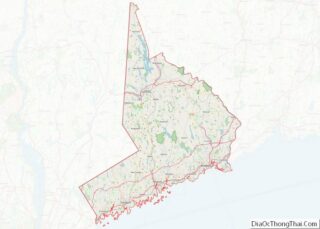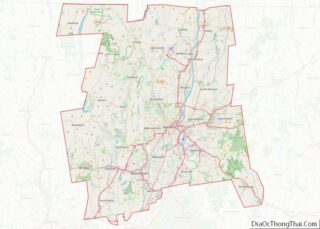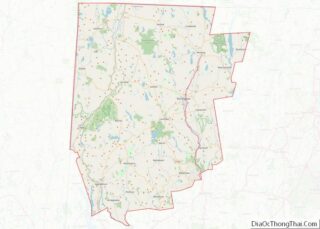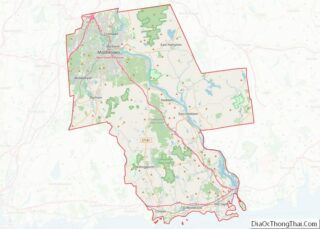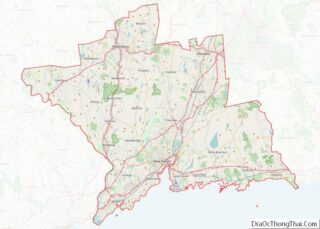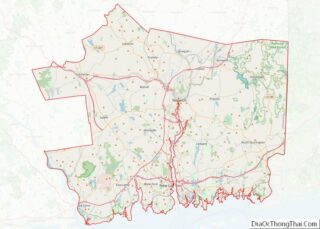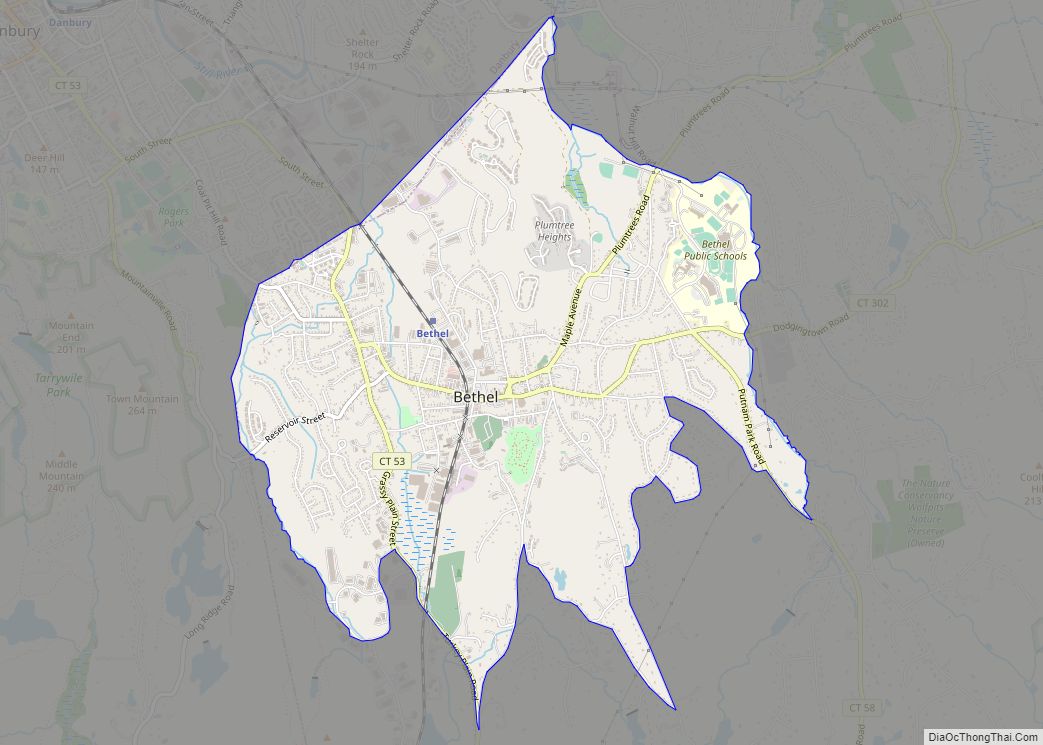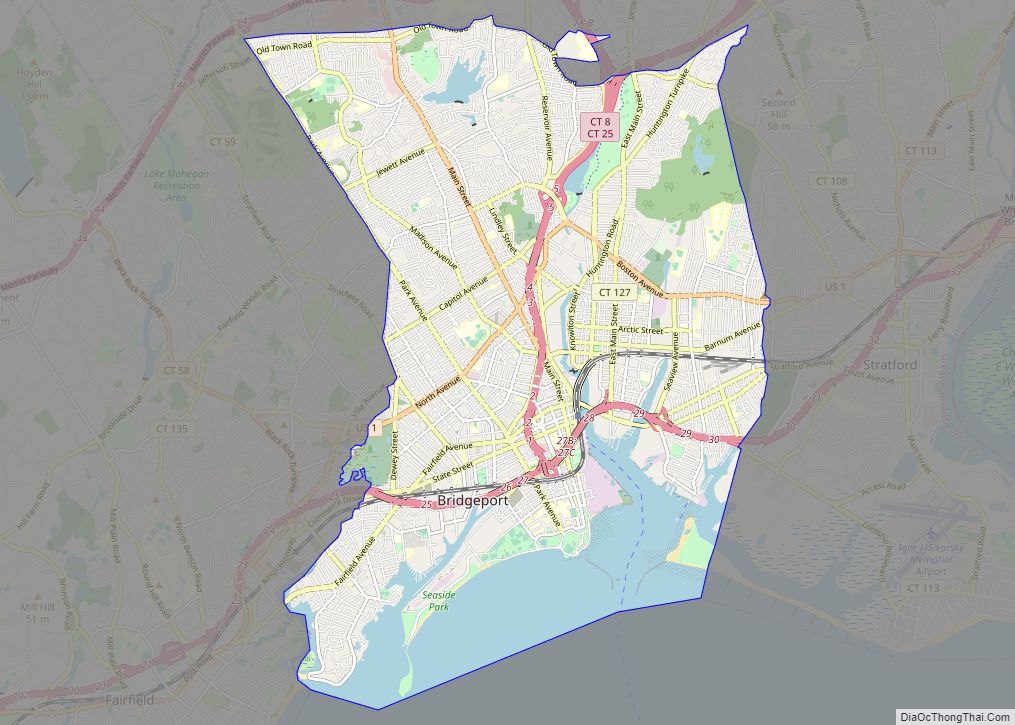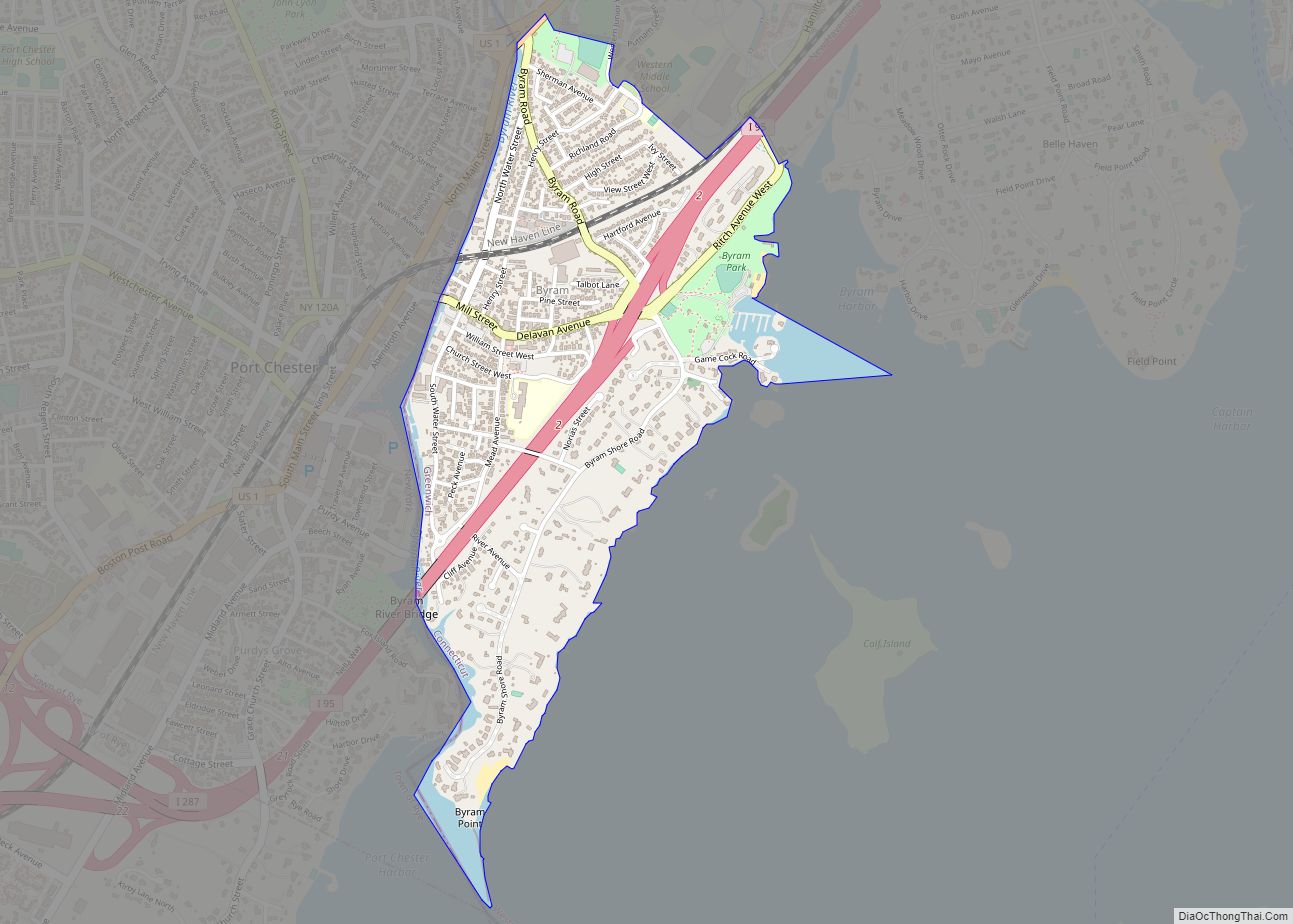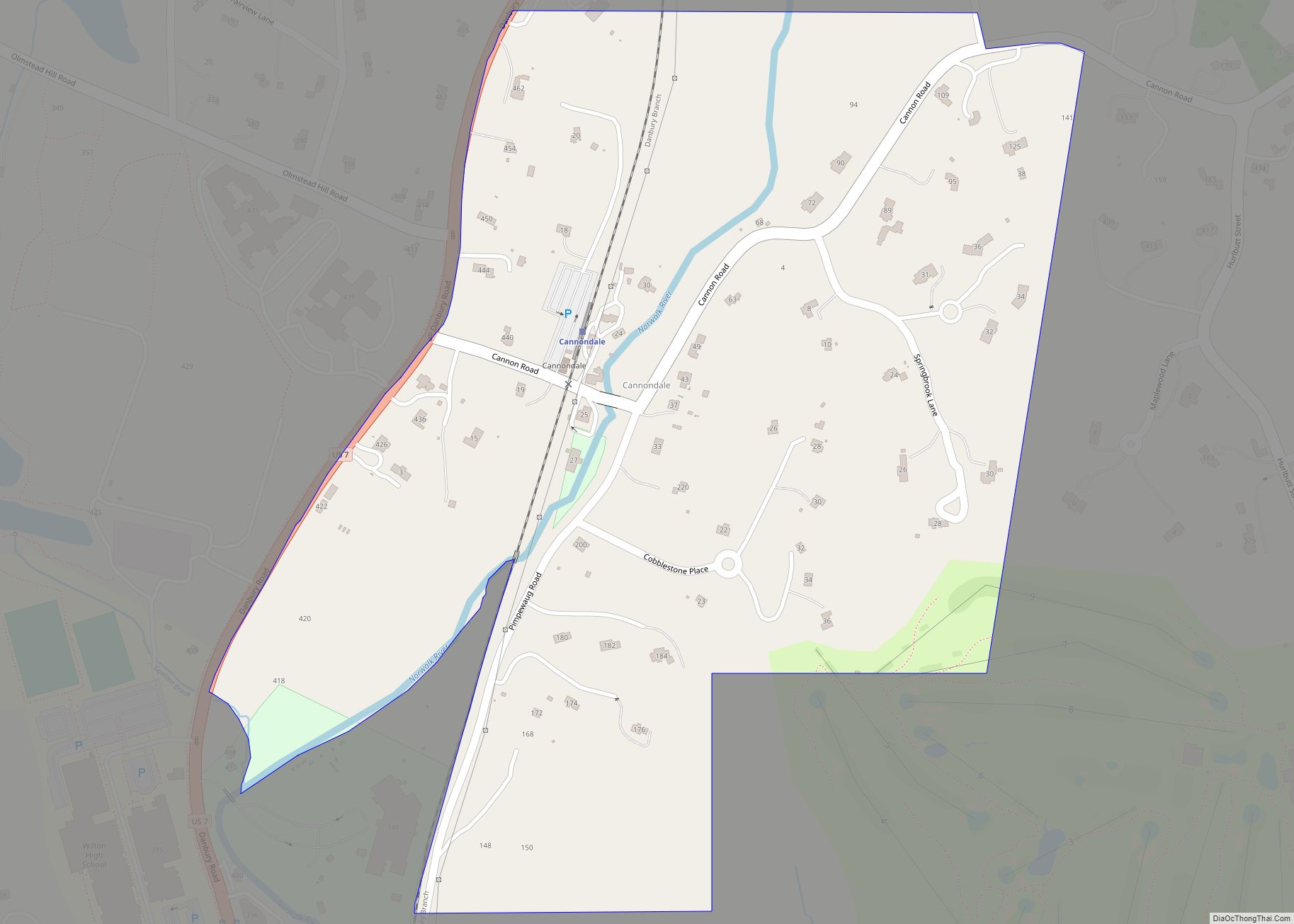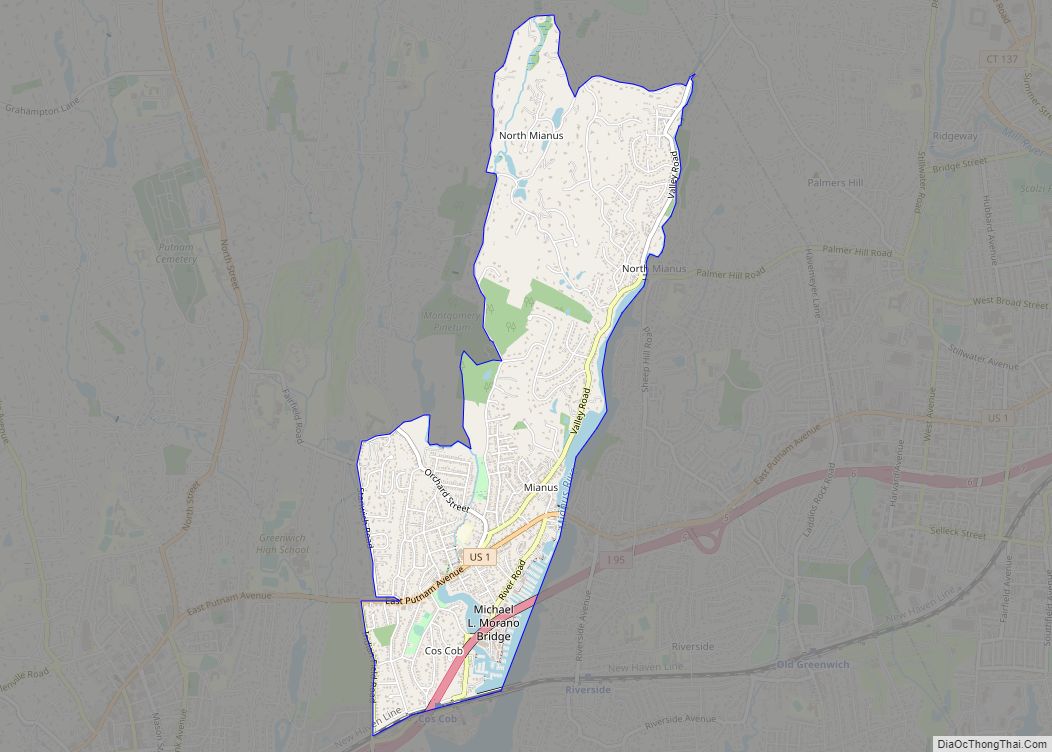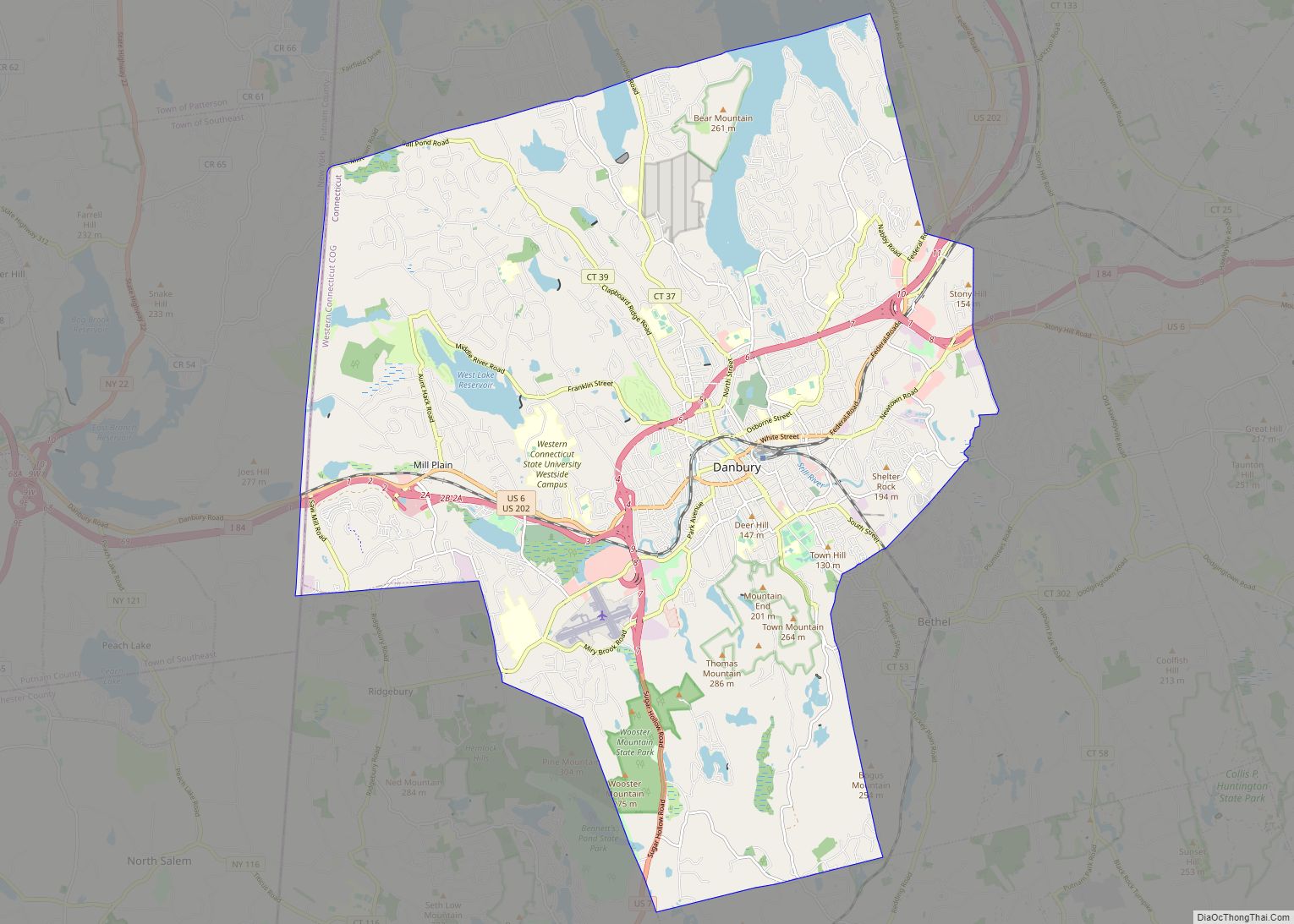Fairfield County is a county in the southwestern corner of the U.S. state of Connecticut. It is the most populous county in the state and was also its fastest-growing from 2010 to 2020. As of the 2020 census, the county’s population was 957,419, representing 26.6% of Connecticut’s overall population. The closest to the center of the New York metropolitan area, the county contains four of the state’s top 7 largest cities—Bridgeport (1st), Stamford (2nd), Norwalk (6th), and Danbury (7th)—whose combined population of 433,368 is nearly half the county’s total population.
The United States Office of Management and Budget has designated Fairfield County as the Bridgeport-Stamford-Norwalk-Danbury metropolitan statistical area. The United States Census Bureau ranked the metropolitan area as the 59th most populous metropolitan statistical area of the United States in 2019. The U.S. Office of Management and Budget has further designated the metropolitan statistical area as a component of the more extensive New York-Newark-Bridgeport, NY-NJ-CT-PA combined statistical area, the most populous combined statistical area and primary statistical area of the United States.
As is the case with all eight of Connecticut’s counties, there is no county government and no county seat. As an area, it is only a geographical point of reference. In Connecticut, the cities and towns are responsible for all local governmental activities including fire and rescue, schools, and snow removal; in a few cases, neighboring towns will share certain resources. The last county seat was Bridgeport, which had served this role from 1853 until 1960.
Fairfield County’s Gold Coast helped rank it sixth in the U.S. in per-capita personal income by the Bureau of Economic Analysis in 2005, contributing substantially to Connecticut being one of the most affluent states in the U.S. Other communities are more densely populated and economically diverse than the affluent areas for which the county is better known.
| Name: | Fairfield County |
|---|---|
| FIPS code: | 09-001 |
| State: | Connecticut |
| Founded: | 1666 |
| Named for: | The hundreds of acres of salt marsh that bordered the coast. |
| Seat: | none; since 1960 Connecticut counties no longer have a county government Fairfield (1666–1853) Bridgeport (1853–1960) |
| Total Area: | 837 sq mi (2,170 km²) |
| Land Area: | 625 sq mi (1,620 km²) |
| Total Population: | 957,419 |
| Population Density: | 1,532/sq mi (592/km²) |
Fairfield County location map. Where is Fairfield County?
History
Fairfield County was the home of many Native American tribes prior to the Europeans’ arrival. People of the Schaghticoke tribe lived in the area of present-day New Fairfield and Sherman. From east to west the Wappinger sachemships included the Paugussetts, Tankiteke, and the Siwanoy. There were also Paquioque and Potatuck inhabitants of Fairfield County.
The Dutch explorer Adriaen Block explored coastal Connecticut in the Spring and early Summer of 1614 in the North America-built vessel Onrust. The first European settlers of the county, however, were Puritans and Congregationalists from England. Roger Ludlow (1590–1664), one of the founders of the Colony of Connecticut, helped to purchase and charter the towns of Fairfield (1639) and Norwalk (purchased 1640, chartered as a town in 1651). Ludlow is credited as having chosen the name Fairfield. Fairfield is a descriptive name referring to the beauty of its fields. The town of Stratford was settled in 1639 as well by Adam Blakeman (1596–1665). William Beardsley (1605–1661) was also one of the first settlers of Stratford in 1639.
Fairfield County was established by an act of the Connecticut General Court in Hartford along with Hartford County, New Haven County, and New London County; which were the first four Connecticut counties, on May 10, 1666. From transcriptions of the Connecticut Colonial Records for that day:
The original Fairfield County consisted of the towns of Rye, Greenwich, Stamford, Norwalk, Fairfield, and Stratford. In 1673, the town of Woodbury was incorporated and added to Fairfield County. In 1683, New York and Connecticut reached a final agreement regarding their common border. This resulted in the cession of the town of Rye and all claims to the Oblong to New York. From the late 17th to early 18th centuries, several new towns were incorporated in western Connecticut and added to Fairfield County, namely Danbury (1687), Ridgefield (1709), Newtown (1711), and New Fairfield (1740). In 1751, Litchfield County was constituted, taking over the town of Woodbury. The final boundary adjustment to Fairfield County occurred in 1788 when the town of Brookfield was incorporated from parts of Newtown, Danbury, and New Milford, with Fairfield County gaining territory from Litchfield County.
Other early county inhabitants include:
- Joseph Hawley (born 1603 in England; died 1690), who had emigrated to America in 1629 and then settled in Stratford in 1650, later becoming Stratford’s first town clerk. Joseph Hawley’s son Ephraim built the Ephraim Hawley House in 1683 in Trumbull that is still standing and serves as a private residence.
- Thomas Fitch (c. 1700–1774), from Norwalk, was a governor of the Colony of Connecticut.
- Gold Selleck Silliman (1732–1790) of the town of Fairfield fought for the Americans during the American Revolutionary War and rose to the rank of brigadier general by 1776. He fought in the New York campaign that year.
During the Revolutionary War, Connecticut’s prodigious agricultural output led to it being known informally as “the Provisions State”. In the spring of 1777, the British Commander-in-Chief, North America General William Howe, in New York City, ordered William Tryon to interrupt the flow of supplies from Connecticut that were reaching the Continental Army. Tryon and Henry Duncan led a fleet of 26 ships carrying 2,000 men to Westport’s Compo Beach to raid Continental Army supply depots in Danbury on April 22, 1777. American Major General David Wooster (1710–1777), who was born in Stratford, was in charge of the stores at Danbury and defended them with a force of only 700 troops. Two years later during a British raid on Greenwich on February 26, 1779 General Israel Putnam, who had stayed at Knapp’s Tavern the previous night, rode away on his horse to warn the people of Stamford. Putnam was shot at by the British raiders but was able to escape. The hat he was wearing with a musket ball hole in it is on display at Knapp’s Tavern in Greenwich (which is commonly, albeit somewhat erroneously, called Putnam’s cottage). In the summer of 1779, General William Tryon sought to punish Americans by attacking civilian targets in coastal Connecticut with a force of about 2,600 British troops. New Haven was raided on July 5, Fairfield was raided on the 7th and burned. Norwalk was raided on July 10 and burned on the 11th. Norwalk militia leader Captain Stephen Betts put up resistance to the invaders, but was overwhelmed by the powerful British raiders and was forced to retreat.
David Sherman Boardman (1786–1864) was a prominent early lawyer and judge in this and neighboring Litchfield County.
On October 7, 1801, Neheemiah Dodge and other members of the Danbury Baptist Association wrote a letter to then-president Thomas Jefferson expressing their concern that as Baptists they may not be able to express full religious liberty in the state of Connecticut whose “ancient charter” was adopted before the establishment of a Baptist church in the state. Jefferson replied in a letter to Dodge and the other members of the Danbury church on January 1, 1802, in which he stated that the First Amendment to the United States Constitution provided “a wall of separation between church and State” that protected them.
An agricultural region, the first railroad was the Housatonic Railroad, construction started 1836 and ended 1840, extending from Bridgeport to New Milford originally, connecting Litchfield County crops to the port in Bridgeport, by passing New York City. The New York and New Haven railroad along the county’s coast was constructed in the late 1840s, which started in New York City and ended in New Haven, connecting Bridgeport, Stamford, Norwalk and all the towns on the coast.
In 1851, the county seat of Fairfield County was moved from the town of Fairfield to the newly founded neighboring city of Bridgeport. This was due to its growing population and industry as the old courthouse erected 1794 was no longer adequate. The first hospital in the county, and the 3rd hospital in Connecticut behind Hartford and New Haven Hospitals, Bridgeport Hospital was founded in 1884 along with Fairfield County’s first nursing school. It would be soon followed by Danbury Hospital (1885), Norwalk Hospital (1893), Stamford Hospital (1896) Greenwich Hospital (1903),St. Vincent’s Hospital in Bridgeport (1903), and Park City Hospital in Bridgeport (1926), which closed in 1993.
By 1900, the largest cities in the county were Bridgeport, Norwalk, Danbury, Stamford and Greenwich. By 1905, Bridgeport had become the principle manufacturing center in the state, and one of the major manufacturers in the New England region behind Boston, Providence, and Worcester, with $44,586,519 total worth of products manufactured without adjusting to today’s money. Stamford and Greenwich had become popular resort towns for New York City’s wealthy.
Connecticut in 1905 was 11th in the United States terms of industrial goods produced, and Fairfield County contained the city with the most total worth of products made, Bridgeport. One-fifth of Connecticut’s population was employed in manufacturing, the state’s largest industry which generated most of its wealth. Bridgeport in 1905 produced 20% of America’s corsets. The 2nd largest city in Connecticut behind New Haven by 1910, Bridgeport’s population grew by 50,000 people during the first 20 months of US involvement during the First World War, producing 50% of Allied ammunition during that time. Bridgeport by 1920 had a population of 143,555 people, then the 44th largest US city. Danbury, in northern Fairfield County, was known as the “Hat City”, producing 20% of America’s hats, until the industry began to decline in the 1920s. Stamford (population 40,067 in 1920), was known as the “Lock City”, as the home of the Yale and Towne Lock Manufacturing Company. Bridgeport, nicknamed “Park City” had in 1930 over 500 factories within its borders. Bridgeport Machines, Inc., a milling machine manufacturer, was founded in Bridgeport in 1938, as well as Hubbell Incorporated in the 1890s, these are two examples, various companies were headquartered in Bridgeport, such as Warnerco, ACME Shear, Westinghouse subsidiary Bryant Electric among others, and others such as Remington Arms, General Electric, Singer Sewing Machines, Sikorsky Aircraft, Carpenter Steel, and countless others, had large scale manufacturing complexes there.
Most of the county remained agricultural. Westport in the 1920s was a bohemian summer artist colony, and was home to famous artists, writers, and painters, such as F. Scott Fitzgerald, who spent a summer in town. The Cos Cob art colony flourished from the late 1800s to the 1920s.
At the height of its influence in the 1920s, the Ku Klux Klan had a distinct presence in the county and county politics. The group was most active in Darien, but had small chapters in Norwalk, Stamford, and Bridgeport. The Klan has since disappeared from the county.
The county’s first institution of higher learning was Western Connecticut State University, founded in Danbury in 1903 (known by its acronym, WCSU), followed by the University of Bridgeport in 1927, Fairfield University in neighboring Fairfield in 1947 and Sacred Heart University.
Nearly one-third of Fairfield County’s population lived within Bridgeport’s city limits in 1950, 31.5%. The city began to decline in population as families moved into nearby suburbs, such as Fairfield, leading to widespread residential development. Bridgeport slowly began to loose jobs and large corporations moved into southern states or outside the country. The city gained a reputation for having an aging industrial image, what New York Times articles described as a smokestack filled, aging view of the city from the highway. The Connecticut Turnpike (Interstate 95) was built in the mid-1950s along the coast, joining the scenic Merrit Parkway, built in the late 1930s to alleviate traffic on the Post Road, and built further inland away from population centers. Towns such as Westport, Darian, New Caanan, Stamford, and Greenwich became New York City suburbs, forming the Connecticut Gold Coast, Fairfield County, along with all other Connecticut counties, was abolished as a governmental agency in accord with state legislation that took effect October 1, 1960. The first enclosed shopping malls in Fairfield County were Trumbull Shopping Park (1963), in the bedroom community of Trumbull just outside Bridgeport, the now gone Lafayette Shopping Park (1965) in Bridgeport, replaced downtown blocks that were demolished as part of the city’s urban renewal, Danbury Fair Mall (1968) on the former fairgrounds of the annual Danbury Fair, Hawley Lane Mallin Trumbull (1971) and the Stamford Town Center (1982) as part of the urban renewal project in downtown Stamford.
Stamford, Connecticut, is an example of edge cityurbanization. Stamford in the 1960s was a residential suburb of New York City, with a few industries and research laboratories, but of Stamford’s downtown was razed and rebuilt it with modern skyscrapers, and several major corporations moved their headquarters to Stamford, creating one of the largest corporate concentrations in the United States. Originally a more moderate plan, entire downtown blocks and streets were demolished in slow phases and replaced with office towers, residential towers and the Stamford Town Center shopping mall courtesy of the F.D. Rich Company, which was hired by the city to redevelop what was described as the aging, deteriorating downtown, throughout the 60s, 70s and early 80s. Stamford’s population grew from 92,713 in 1960 to 135,470 people in 2020, making it the 2nd largest city in Connecticut in 2022 (behind Bridgeport), surpassing New Haven.
Fairfield County Road Map
Geography
Land
According to the United States Census Bureau, the county has a total area of 837 square miles (2,170 km), of which 625 square miles (1,620 km) is land and 212 square miles (550 km) (25.3%) is water.
The terrain of the county trends from flat near the coast to hilly and higher near its northern extremity. The highest elevation is 1,290 feet (393 m) above sea level along the New York state line south of Branch Hill in the Town of Sherman; the lowest point is sea level itself.
The Taconic Mountains and the Berkshire Mountains ranges of the Appalachian Mountains run through Fairfield County. The Taconics begin roughly in Ridgefield and the Berkshires begin roughly in Northern Trumbull, both running north to Litchfield County and beyond. A portion of the Taconics also is in rural Greenwich and rural North Stamford in Fairfield County and run north into Westchester County, New York, eventually re-entering Fairfield County in Ridgefield. A small portion of the Appalachian Trail runs through Fairfield County; the trail enters Connecticut in the northernmost and least populous town in the county, Sherman, and moves east into Litchfield County, which encompasses the majority of the Appalachian Trail in Connecticut.
The section of the Taconic Mountains range that runs through Greenwich and North Stamford of Fairfield County is also the part of the Appalachians that is closest to the coast out of the entire Appalachian Mountains.
Water
The agreed 1684 territorial limits of the county are defined as 20 miles (32 km) east of New York’s Hudson River, which extends into Long Island Sound with a southerly limit of half way to Long Island, New York. The eastern limit is mostly a natural border defined as the halfway point of the Housatonic River with New Haven County with the exception of several islands belonging wholly to Stratford. The depth of the Sound varies between 60 and 120 feet (37 m).
The county hosts or contains the rivers Byram, Housatonic, Mianus, Mill, Norwalk, Pequonnock, Rippowam, Saugatuck, and Still.
The Still River is polluted with mercury nitrate from the hat industry in Danbury, also thereafter diluting into the Housatonic River and Long Island Sound.
The Housatonic is residually polluted with Monsanto chemicals called Aroclor, polychlorinated biphenyls, or PCBs. From c. 1932 until 1977, the river received PCB pollution discharges from the General Electric plant at Pittsfield, Massachusetts.
Mountains and summits
Refer to List of Mountains and Summits in Fairfield County, Connecticut.
Adjacent counties
- Litchfield County (north)
- New Haven County (east)
- Westchester County, New York (southwest)
- Putnam County, New York (west)
- Dutchess County, New York (northwest)
- Nassau County, New York (south)
National protected areas
- Stewart B. McKinney National Wildlife Refuge (part)
- Weir Farm National Historic Site
Major highways
- I-84
- I-95 / Conn. Turnpike
- I-684
- US 1
- US 6
- US 7
- US 202
- Route 8
- Route 15
- Route 25
- Route 34
- Route 37
- Route 110
- NY 120A
- Route 123
